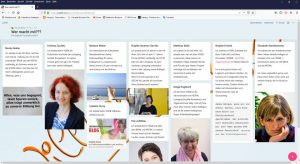
Experienced seminar participants know the situation: you enter the seminar room, look for a seat, cast curious glances at the others present, participants and trainers…
And then it starts: the inevitable round of introductions… In turn, everyone says what their names are, which union and which company they come from and what they expect from the seminar that is just beginning. Preprogrammed boredom…
Whats the point?
The sense and aim of the introduction round is obvious – and with it the realization that it is not possible without just that. Nevertheless, let’s take a closer look at the objectives that can be achieved using introduction rounds:
- Trainers get to know their participants: Of course – trainers need to get a feeling for who they are dealing with in the seminar. What kind of background and experience, what kind of previous knowledge they bring along. Trainers have already received basic information in the preliminary discussion for the planning of the seminar, yet the introduction round offers the opportunity to supplement this with personal observations: Who are the self-confident, extroverted participants and who is more reserved? Only in this way can trainers optimally adjust their moderation to the participants and ensure that everyone benefits equally
- Participants get to know each other: The same applies here, of course. Participants often have no information at all about who else is going to participate before the seminar begins. The introduction round provides basic information and a first impression of the other participants and thus offers the possibility to position oneself in the group
- The icebreaker function – everyone has to talk: Even if you only reveal irrelevant information – during the introduction round, all participants must speak and present themselves. The first hurdle for speaking in the group is thereby already taken, which makes it easier to take part in discussions during the seminar
- Warming up with and in the group: The short communication during the introduction round is the basis for all further group processes, in a way the first „sniff“. A personal basis has been established between all those present, a friendly atmosphere has been created – now you can start
- The indispensable ritual: Even if participants often claim to be annoyed by introductions – if it is missing, something is simply missing. And will certainly be requested by someone from the group within a very short time.
When and where – the didactic place
This is really obvious: at the beginning of course! At the beginning means when all participants have arrived and settled in, i.e. when they have found a place to sit, unpacked their things, spread them around and made themselves comfortable. It doesn’t make sense to give participants time to start an introduction round while a part of the group is still nervous and inattentive. If a person is not present, the trainer can ask the group if they have any further information about a possible delay and if they should wait a few more minutes. Of course it is not ideal to start with an incomplete group – as all trainers know from painful experience, it is often unavoidable. But in any case you should start with the agreement of the group. Then it is clear to everyone that someone is still missing and it is less irritating if the person arrives late and bursts into the introduction round.
Allergy triggers

Now that it is apparent to us why introduction rounds are absolutely sensible and necessary and all their advantages are obvious: Why are participants still annoyed by the procedure???
- The same thing over and over again..: We have already mentioned it in the short introduction: seminar participants often complete training courses, i.e. they attend courses on law, economics or social competence which can be modular in structure or even take place in the same group entirely, such as trade union school, works council academy or social academy.
So they have often already experienced many rounds of introductions. Unfortunately, these often follow the text-book pattern described in the introduction and are therefore methodologically uninspiring.
The repetition effect is of course intensified in continuous courses – here only the respective trainers are new, the group knows each other for a long time and has already recited the usual basic information to each other several times. You can’t blame anyone if thoughts wander off or the smartphone is pulled out…
- Booooooring info: Yes, it’s important from which union the participants come and how long they have been works council members… But, honestly: Are these the things that really interest you most in an unknown counterpart? Or don’t we want to know quite different things: What do these people actually do in their free time? Do they have family, children? What are their hobbies and interests? Personal information and minor details arouse interest, create a common basis and a relaxed atmosphere in the group
- Time eater: Already a whole hour is gone and still no content! Presentation rounds can cost quite a lot of time – if there are 15 participants who really keep it short, and really only the basics are discussed, you can get away with half an hour. BUT. If you just want to tell a little more than the basics mentioned above, and then maybe there are one or two particularly mission-conscious people in the group… We all know show rounds that have gotten out of hand. And first and foremost, participants don’t come to meet new people, but because they want to learn something, to deal with a certain topic. They should not have to wait too long for that
- Stage for self-promoters: This is directly related to the topic of time eaters. Some participants find themselves particularly exciting and interesting and therefore want to share their valuable experiences and insights with their fellow participants during the introduction round! Basically a commendable approach – only if we share our experiences we can learn from each other – but in the introduction round only a first impression should be given and nothing more. Mission possible for the trainers is to keep the statements short without rudely interrupting the participants
- Not brain-friendly: Information from introductions is difficult to remember. There are too many, too similar and too trivial things, of which our brain usually stores only little.
Alternatives- how can it be done in a better way?
The beginning is actually not the beginning…
Creating a friendly, relaxed atmosphere is a basic requirement for a successful seminar. However, trainers can start before the seminar actually begins, using both digital and analogue methods – this means that the actual introduction round in the seminar can be kept shorter and the hunger for “content” is satisfied more quickly!

- The digital introduction round
On a digital pinboard like Padlet, participants can introduce themselves to each other a few days before the actual seminar begins. To do this, the trainers write an email with some questions to everyone in advance and ask them to post the answers and ideally also a photo on the digital pinboard. This is fun, you can literally get a picture of the others and start the seminar with some information! It can look like the photo, for example.
You can find more information about the use of Padlet in the seminar in #dido_17!
- Completely old school: List of participants and preliminary meeting
Already in the preparation of the seminar, trainers should obtain information about the participants. This can be done by submitting the registration lists and during a preliminary discussion with the course management. The boring basic information can already be collected, paving the way for being able to concentrate on the really exciting questions
- Also old, but good: small talk!
Ideally, the trainers arrive before the participants. Then they can greet them personally and have a little small talk with them – did you have a good journey? How is the hotel?… This creates a positive atmosphere and you can get some information out of it
- The unknown group and us trainers
Especially in longer courses, where participants know each other already, “collective allergies” have developed over time. These are things that are highly unpleasant for the group and can make you really unpopular as a trainer. The easiest trick here: Asking!
Trainers can simply ask very directly: “Is there anything I should know about you as a group or what you are allergic to?” This can only have a positive effect: trainers spare themselves and the group unnecessary frustration
- „What was your name again?“
Not all trainers are geniuses at memorizing names immediately… The good old name badges that either stand in front of the participants or can be attached to the person in some way or another can help here. Especially in long courses name tags are often forgotten – the participants already know each other and the name tag is not that important anymore. But for the trainers it is! Therefore, also in this case: Just ask the group to use name tags!
Leaving the text-book approach behind!
It has long been known in the trainer community that it is always boring to have the same introduction rounds. In order to remedy this, many clever people have written many clever method books or blogs etc., in which you can find lots of introduction games. Do some research and get inspired – but be careful when using them: Introductory games have to fit the trainer, the group and the occasion, and often less is more. But we would like to introduce a few of them to you anyway. We have concentrated on methods that are easy and uncomplicated to implement and can also be adapted individually!
Move away from the boring information!
- BPA-Analysis
- SMART-Start: Participants introduce themselves – with the help of their own mobile phone photo
- Interviews
- Triads
Setzt eure Kreativität ein!
And hop, hop, hop into the subject
- What do we already know about it?
Authors: Pia Lichtblau, Ulli Lipp
Translation: Astrid Donaubauer
Read original article in German

Dieses Werk ist lizenziert unter einer Creative Commons Namensnennung-NichtKommerziell-Weitergabe unter gleichen Bedingungen unter gleichen Bedingungen 3.0 Österreich Lizenz.
Volltext der Lizenz

